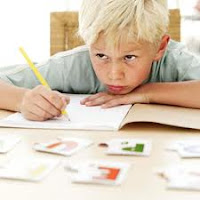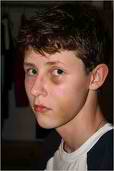A major cause of agony for Aspergers (high functioning autistic) students, their parents and educators is the unsatisfactory completion of homework. These children often have an emotional reaction to the mere thought of having to start their homework – and have difficulty completing assigned tasks. There may be two explanations for this: (1) their degree of stress and mental exhaustion during their day at school, and (2) their cognitive profile.
School-Related Stress—
 As with their classroom peers, a youngster with Aspergers has to learn the traditional educational curriculum, but they encounter additional learning experiences and sources of stress than do other kids in their class. They have an additional curriculum, namely the social curriculum. They have to use their intellectual reasoning to determine the social rules of the classroom and the playground. Other kids do not have to consciously learn social integration skills, but Aspergers kids have to decipher the social cues and codes and cognitively determine what to do and say in social situations.
As with their classroom peers, a youngster with Aspergers has to learn the traditional educational curriculum, but they encounter additional learning experiences and sources of stress than do other kids in their class. They have an additional curriculum, namely the social curriculum. They have to use their intellectual reasoning to determine the social rules of the classroom and the playground. Other kids do not have to consciously learn social integration skills, but Aspergers kids have to decipher the social cues and codes and cognitively determine what to do and say in social situations.
Often their primary feedback is criticism for an error with little recognition from others when they make the correct response. Learning only from your mistakes is not the most efficient way to learn. Thus, Aspergers kids have to concentrate on an extra curriculum that leaves them intellectually and emotionally exhausted at the end of the school day.
They also have difficulty reading and responding to the emotional signals of the educator and other kids, coping with the complex socializing, noise and chaos of the playground, the unexpected changes in the school routine and the intense sensory experiences of a noisy classroom. Throughout the school day, they rarely have an opportunity to relax.
It is essential that teachers recognize the degree of stress experienced by Aspergers students, as the signs can become evident in their behavior and mood. The signs include the youngster who is described as a Dr. Jekyll and Mr. Hyde in that the indicators of stress are not conspicuous at school, but the youngster is a very different character at home. They may be quiet and compliant in the classroom, but intolerant and aggressive immediately they return home.
Some Aspergers kids become extremely anxious in the morning before going to school, and school refusal or walking out of school can be a sign of unbearable stress. Other kids can express the signs at school by episodes of extreme anxiety or anger, with incidents of panic or disruptive and explosive behavior. Others suffer chronic stress, which contributes to a clinical depression.
Kids with Aspergers who are having difficulty learning the social curriculum and coping with the stress of school often explain that they want a clear division between home and school. Their general view is "school is for learning, and home is for fun or relaxation." Thus, the prospect of interrupting their much needed and deserved fun and relaxation with homework is more than they can cope with.
Cognitive Profile—
Kids with Aspergers have an unusual profile of cognitive skills that must be recognized and accommodated when they are undertaking academic work at school and home. One aspect of the profile is impaired executive function. The profile is similar to that of kids with ADD in that they can have difficulty planning, organizing and prioritizing, a tendency to be impulsive and inflexible when problem solving and poor working memory. Other features include a difficulty generating new ideas, a need for supervision and guidance and determining what is relevant and redundant as well as poor time perception and time management. There is also the likelihood of an unusual profile on standardized tests of intelligence, especially with regard to verbal and visual intelligence.
Some kids are ‘verbally-oriented’ and have a relative strength in reading, vocabulary and verbal concepts, while others are ‘visually-oriented’ and ‘a picture is worth a thousand words’. The youngster’s cognitive and learning profile is usually recognized by school authorities and special provision made for the youngster in terms of an assistant in the classroom to facilitate their academic progress. The educator knows how to adapt the curriculum for a youngster with Aspergers, but this knowledge and service are not usually available at home.
The following range of strategies are designed to minimize the impaired executive function, accommodate their profile of cognitive skills, and help Aspergers youngsters complete their homework assignments with less stress for the youngster and family.
Learning Environment—
1. A daily homework timetable can be made by a mother/father with guidance from the educator to define the expected duration and content of each homework activity or assignment. This can be extremely helpful if there are problems with the youngster’s allocation of time to each homework component. Sometimes the homework can take hours when the teacher intended only several minutes on a specified task.
2. A timer can be used to remind the youngster how much time is remaining to complete each section of homework. It is also important to ensure that time scheduled for homework does not coincide with the youngster’s favorite television program. If it does, they may have priority use of the video recorder and can watch the program after their homework.
3. If regular breaks are necessary to promote concentration, the work can be divided into segments to indicate how much work the youngster has to complete before they can take a momentary break. The usual mistake is to expect too much prolonged concentration.
4. The area where the youngster works must be conducive to concentration and learning. A useful model is the youngster’s classroom with appropriate seating, lighting and removal of any distractions. The distractions can be visual such as the presence of toys or television, which are a constant reminder of what the youngster would rather be doing or auditory distraction such as the noise from electrical appliances and the chatter of siblings. Ensure the working surface only has equipment relevant to the task. Their working environment must also be safe from curious siblings.
Preparation of Homework—
The educator can highlight key aspects of the homework sheet, written material and questions so that the youngster knows which aspects are relevant to their preparation of the assignment. They can ask the youngster to formulate their plan before commencing the assignment to ensure their work is coherent and logical, especially if the homework is an essay. If the assignment takes several days to complete, it is important that the educator regularly reviews the youngster’s rough drafts and progress, which also increases the likelihood that it will be completed on time.
Memory Problems—
1. If the Aspergers youngster has difficulty remembering exactly what was set for homework and remembering relevant information during homework, a characteristic of impaired executive function, a solution is to buy an executive toy. A small digital recorder used for dictation can provide a record of the educator’s spoken instructions and the youngster can add his or her own comments or personal memo to the recording to remind them of key information. The youngster and their mother/father will then know exactly what was said and what is relevant to the task.
2. Another strategy is to have the telephone number of another youngster in the class to ask them for the relevant information.
3. A homework diary and planner can help the youngster remember which books to take home and the specific homework for each evening. An executive diary from a stationary store may make this strategy more appealing to the youngster. The techniques are explained as being appropriate for adult executives rather than for kids with learning problems.
Supervision—
The youngster may have difficulty getting started or knowing what to do first. Procrastination can be an issue and a mother/father may have to supervise the start of the homework. Once the youngster has started, this is not the end of the supervision. A parent will also need to be available if the youngster requires assistance when they are confused and to ensure that they have chosen the appropriate strategy. There can be a tendency for such kids to have a closed mind to alternative strategies and a determination to pursue an approach when other kids would have recognized the signs that it would be wise to consider another approach. A technique to show that there is more than one line of thought is to provide the youngster with a list of alternative strategies to solve the particular problem. The youngster may need to know there is a plan ‘B’.
Moms and dads and educators soon become aware of the degree of supervision required which can be a major problem for a mother/father with other family commitments when the youngster is doing their homework. Supervision is also necessary to help the youngster priorities, plan, assist with word retrieval problems and maintain motivation. Motivation can be enhanced by specific rewards for concentration and effort
Emotional Management—
Kids with Aspergers are notorious for their difficulty coping with frustration and criticism, and their inability to manage their emotions. They can become quite agitated when confused or having made a mistake. A grown-up will need to be available to help the youngster remain calm and logical. The adult will also need to model calmness, which can be difficult when both youngster and adult are confused as to what to do. It can end in tears for both parties.
Cognitive Style—
1. One characteristic is a difficulty explaining their reasoning using speech. The youngster may provide the correct solution to a mathematical problem, but not be able to use words to explain how they achieved the answer. Their cognitive strategies may be unconventional and intuitive rather than deductive. One may need to accept their correct solution even if the logic is unclear to the neurotypical mind. One problem with this characteristic is that it may be difficult for the mother/father to correct the alternative reasoning when the youngster has a ‘mental block’.
2. If the mother/father is unable to help the youngster solve a particular problem, a solution is to come to an arrangement with the teacher where by he/she is contacted by telephone without hesitation as to the time of day or night and they can talk directly to the youngster. Regular use of this approach can lead to a significant reduction in the type and amount of homework.
3. Kids with Aspergers often enjoy having access to a computer and may be more able to understand material if it is presented on a computer screen. Material presented by a person adds a social and linguistic dimension to the situation, which can increase the youngster’s confusion. Educators should consider adapting the homework so that a considerable proportion of the work is conducted using a computer. Word processing facilities, especially graphics and grammar and spell check programs are invaluable in improving the legibility and quality of the finished product.
4. Kids with Aspergers require special consideration when learning new material. Homework should primarily be designed to consolidate and practice known information rather than introducing new concepts.
5. Special consideration should be given to the youngster’s cognitive strengths and weaknesses. If the youngster’s relative strength is in visual reasoning, then flow diagrams, mind maps and demonstrations will enhance their understanding. If their strength is in verbal skills then written instructions and discussion using metaphors (especially metaphors associated with their special interest) will help. Additional strategies include the use of a computer and keyboard, especially for those kids who have problems with handwriting. Sometimes a mother/father acts as an ‘executive’ secretary and types the material for the youngster and proof reads their answers. Homework may be a collaborative rather than solitary activity. The parent is not being over protective or neurotic, they just know that without their involvement, the work would not be done.
6. Teaching a youngster with Aspergers requires special skills and a mother/father is not expected to have those skills. As a parent, one is also more emotionally involved than a class teacher and it can be difficult for them to be objective and emotionally detached. One option is to hire a homework tutor to provide the skilled guidance and supervision. However, this may be beyond the financial resources of most families.
Completing Homework at School—
If homework is associated with a lot of stress and agony, there are a few things that can be done to (a) reduce the despair of the youngster who is exhausted from his day at school, (b) the mother/father who tries to motivate their youngster, and (c) the educator who recognizes that homework is not the most effective means of education for such a child. If the regular amount of homework is demanded of the youngster, then everyone must recognize the considerable degree of time and commitment that is necessary from all parties to ensure it is completed satisfactorily and on time.
One option is to enable the Aspergers youngster to complete his ‘homework’ at school. It can be undertaken at lunchtime and before or after classes in their home class or the school library. However, they would still require supervision and guidance from a teacher or assistant. In high school, some kids have been able to graduate taking fewer subjects and the extra time available in the school day dedicated to homework.
Being Exempted from Doing Homework—
If all these techniques are unsuccessful, here is a last ditch effort: Allow the Aspergers student to be exempted from doing homework – yes, you heard correctly – exempted! If the strategies outlined above are unsuccessful or unable to be implemented, then forget about homework. Sometimes this advice is to the great relief of the youngster, his mother and father, and the educator.
More resources for parents of children and teens with Asperger's and High-Functioning Autism:
==> Preventing Meltdowns and Tantrums in Asperger's Children
==> Discipline for Defiant Asperger's Teens
==> Teaching Social Skills and Emotion Management
==> Launching Adult Children with Asperger's: How to Promote Self-Reliance
==> Everything You'll Ever Need to Know About Parenting Asperger's Children
==> Parenting Children and Teens with High-Functioning Autism
==> AudioBook: Unraveling The Mystery Behind Asperger’s and High-Functioning Autism
==> Parenting System that Reduces Problematic Behavior in Children with Asperger's and High-Functioning Autism
COMMENTS:
• Anonymous said… We struggled for so long with this every night it was taking 2 hours to do, most of that was us telling him what to write. We eventually asked his teacher what kind of credit he was getting out of the two hours of work he was struggling to do, she simply said none. I asked my son one day what does she do with your homework when you turn it in? He said nothing she throws it in the trash. Well I told him to stop doing it. So of course he went back to school and when he didn't have his homework done she asked where is it. My son simply said Mom and Dad said I don't have to do it anymore. This was before we had a diagnosis and after a year of right ups and ISS, you name it.
• Anonymous said… We also have struggled with this for many years our son is now 14 we gave up I would rather have quality time than yelling n tantrums every day especially as we have 3 kids in total homework I believe is not the be all and end all of schooling... With very high anxiety it is not worth the battle.. Hope u find a happy medium.
• Anonymous said… Homework is a toughie. It's hard after school because our kids need space to recover from the day. I talk to the teachers about giving my son the absolute minimum. Then I use a visual board that sits next to his homework spot and I give him rewards for completing each task. I try to step back and not take on responsibility for it. It is his homework and my goal is to provide the structure and communicate with the teacher if he is to wrecked to do it. I hope this helps but it is hard.
Post your comment below…






.jpg)


